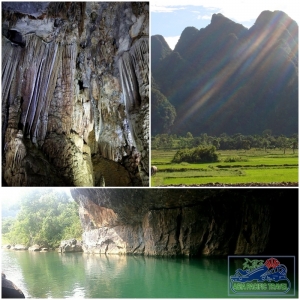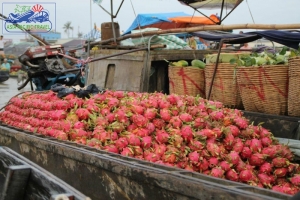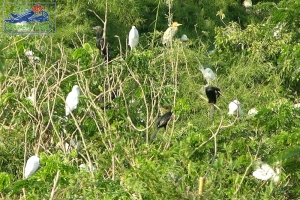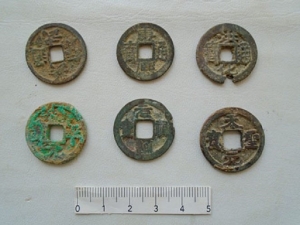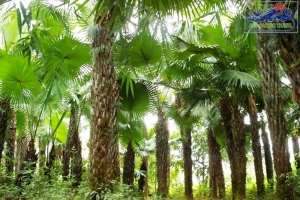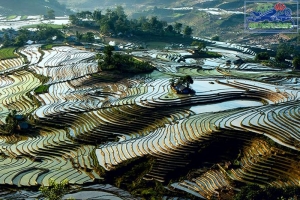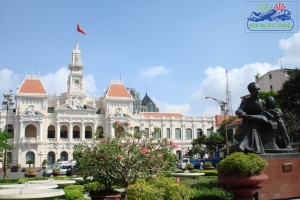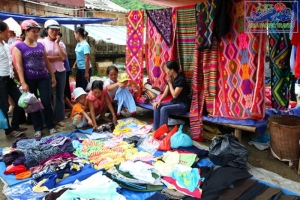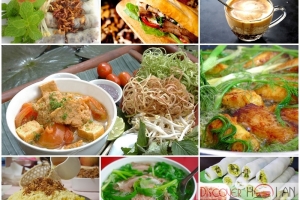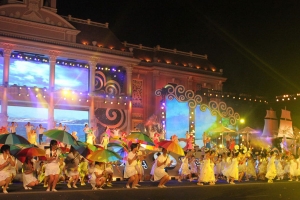
Asia Pacific Travel Team
Quang Binh finding investors for major tourism projects
Quang Binh Province on the central coast is looking for domestic and foreign investors to develop around 35 major commercial and tourism projects with combined capital of more than VND23.4 trillion (over US$1 billion).
Mekong Delta orchards during harvest season
Fruit orchards in the Cuu Long (Mekong) Delta, the country's largest fruit cultivation area, are now in the harvest season.
Tourism festival to be held at Tram Chim National Park
The Cuu Long (Mekong) Delta province of Dong Thap will organise a tourism festival at the Tram Chim National Park in Tam Nong District on September 25.
The festival will include a photo exhibition about the national park, a world Ramsar site (wetland of international importance), a bird contest and tours to view the park during the delta's flooding season.
The 7,612-ha national park is among the delta's most beautiful destinations during the flooding season. It has a vast area of green cajeput trees, and beautiful lotus and water lily flowers.
The park, which is one of the country's eight most important bird conservation areas, has 198 bird species, including red-headed cranes listed in the World Red Book of endangered species.
VNS
Discovering collection of ancient coins in Bac Kan
Local people and workers discovered a jar containing ancient coins at Nam Cat Reservoir construction site in the northern Bac Kan Province.
Some researchers from the provincial museum investigated the area and collected 14kg of coins, which are estimated to have been buried at the end of the 18th century.
The coins are from Viet Nam, China and Japan. The museum received an ancient jar at the 18th century including many moneys from Vietnam, China and Japan. Moneys from some dynasties: Le dynasty, Ly dynasty, Nguyen dynasty, Minh dynasty, Tong dynasty and Thanh dynasty from China.
Discovering the jar to mark a great value and meaning of Bac Kan provincial culture and history. It is a condition to study and discover some archaeological documents in Bac Kan land nowadays.
Scientists said the discovery proved the existence of well-developed trade relations between the locality and other regions in the second half of the 18th century.
Source: Cinet
Phu Tho - The land of palm trees
The northern midland province of Phu Tho is where palm trees can be found in the middle of paddy fields.
No one knows when palm trees started growing in this land but Phu Tho residents usually say: “Our land is that of palm trees. Everywhere in our hometown, people can see green palm hills.”
For people of Phu Tho, every part of palm tree is useful, especially when it comes to food.
Palm leaves are helpful for people who hide themselves from burning sunlight and can also be used to make a local specialty.
A variety of dishes can be made from palm fruit. The ripe palm fruit is plump and has a purple color. It tastes greasy after being soaked in hot water for 15 minutes. The boiled palm fruit also goes well with sticky rice. To make rice softer and more fragrant, it can be mixed with palm fruit oil while the orange color from the boiled palm fruit can be blended with white sticky rice to create an eye-catching color for the dish.
Salted palm fruits are a specialty of Phu Tho. They are as sour as other pickles but what makes it special is its grease.
Trunks of young palm trees can be processed into food. The core inside the trunk of a young palm tree is soft and white and is fried with long coriander to make a dish claimed to be good for health.
Even with a rotten trunk, people can still create food by leaving it on wet soil to wait for worms which feed on the trunk to grow. When those palm worms become as large as fingers, they can be deep fried. According to elders, fried palm worms are rare as few people can raise worms from rotten palm trunks.
Source: SGT
Muong Khum, Bat Xat - New tourism destination in Lao Cai
Muong Khuong and Bat Xat districts in the northern mountainous province of Lao Cai boast high potential for tourism development alongside popular destinations like Sa Pa town and the Bac Ha market.
The districts are endowed with striking natural scenes and rich cultures suitable for developing eco-tourism and community-based tourism.
Sitting in the northeast part of Lao Cai, Muong Khuong is home to 16 caves scattered across 15 communes and towns, including Ham Rong, Ta Lam, Nam Ooc and Seo Tung caves.
The People’s Committee of Muong Khuong district has set aside VND34.4 billion (US$1.67 million) to restore and upgrade local heritage sites between 2011 and 2015.
The district has been upgrading clusters of caves and building more traditional craft and cultural villages such as brocade weaving villages in Sa Pa, Coc Ngu, Na An and Di Thang.
Along highway 4E connecting Muong Khuong and Si Ma Cai – dubbed the sleeping princess in Bac Ha district – visitors can pop into cultural villages such as Sin Cheng, Can Cau and Bac Ha.

Vice Chairman of the district’s People’s Committee Pham Ba Uyen said the five-year tourism development project is intended to move a number of workers in agriculture production to trade and services sectors in order to preserve and promote the traditional cultures of ethnic groups.
Located in the southwest part of Lao Cai, Bat Xat district is famous for its Y Ty primary forest and A Mu Sung Mountain.
Tourists can take a nearly 150-kilometre journey by car or motorbike to visit Sa Pa and Bat Xat towns or Y Ty and Muong Hum communes and explore the stunning landscapes and vibrant cultural lifestyle of ethnic minority people such as Giay, Dao, Mong and Ha Nhi.
To tap the tourism potential, Bat Xat district has been launching tours, building community-based cultural sites such as Lung Lo, Lao Chai, Den Sang, Muong Hum and Ban Xeo, each featuring the unique culture of different ethnic groups and becoming a must-see destination for foreign visitors.
Authorities have also built a development strategy to create a new tourism image in the district, including better management of tourism services and opening training courses for tourism staff.
They also encouraged the involvement of businesses and families while activating promotion programmes and building infrastructure systems to develop community-based tourism, said Chairman of the local People’s Committee Bui Huu Loi.
According to the local Department of Culture, Sports and Tourism, Lao Cai welcomed over 1 million visitors in the first six months of 2015, a year-on-year rise of 15%.
The tourism sector garnered nearly VND2.3 trillion (US$103 billion) in revenue in the period, a yearly increase of 15%. Sa Pa, Bac Ha, Bat Xat and Muong Khuong are the most popular destinations with 20%-30% growth in the volume of visitors.
Source: VNA
Ho Chi Minh City has eight more relics
HCMC authorities have recognized eight more cultural and architectural buildings as relics, taking the number of relic buildings in the city to 100.
A trip to Mai Chau - Home of Muong people
Only a 3-hour drive with the route of 130 kilometers from Hanoi, Mai Chau – with peaceful space and fresh air – has become an ideal getaway to unwind from all the stress and retreat from the hot summer days in the bustling city.
Mai Chau suits all individuals – lovers, family or students, etc., especially newly married couples. Zankyou, a famous French magazine, ranked Mai Chau as one of the top 10 ideal destinations for honeymooners.
Mai Chau will astonish you with its changing mild beauty through every season of the year. In summer, Mother Nature covers the land with beautiful wild flowers, together with the pure smells from lotus lakes scattered in the villages.

The immature taste of rice alongside the cycling trails reminds us of our childhood. Under the brilliant sunset, the lush paddy fields seem to be gilded by sunlight fading away behind the blue mountains. At night, gathering around a home-made wine bottle, tourists seem to be immersed in the deep melody of colorful Thai dance together with thrilling bullhorn and drum voices, an unchanging habit for many generations.
Recently, Mai Chau has seen a sharp rise in the number of international travelers thanks to its orientation in developing ecotourism.
It is known for being close to nature and its efforts in environmental protection, cultural and sustainable tourism. Mai Chau is gradually becoming a fragrant flower on Vietnam tourist map.

Many visitors pass by word of mouth stories about a resort situated on a small hill, surrounded by traditional Thai stilts house with special palm tree roof. They say that it is a village of indigenous architecture characterized by Lang Mandarin’s house in the center and others around.
Inside is an ecological green heaven with charming bungalows overlooking the valley, modern pool on mountain, paved walkway and local trees. There is a perfect harmony between people and nature in Mai Chau.
To experience the culture and lifestyle, to indulge in nature and to enjoy exploring the land of Mai Chau should be done at least once in a lifetime. So, are you ready for the journey to explore Mai Chau – a beautiful flower of Muong land?
Source: Vietnamnet.vn
10 dishes you must try next time you're in Ha Noi
No matter where you go around the globe, every major city puts its own spin on food, whether they're serving a slightly different version of a familiar favourite or a strange (to you) dish.


